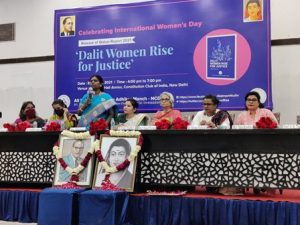Dalit Women & Justice: Report highlights grim increase in figures of rape, violence
The report finds a 56.8 per cent increase in rape of Dalit women from 2014-2019, with UP, MP, and Rajasthan topping the list of violence against Dalit women based on SCs & STs (PoA) Act.
Crime against Dalit women has increased by 46 per cent between 2014 and 2019, reveals a report published recently by the human rights organization All India Dalit Mahila Adhikar Manch (AIDMAM). Titled ‘Dalit Women Rise for Justice’, the report brings to light the surge in violence and oppression towards women from Scheduled Castes and Scheduled Tribes across the country.
Women Rise for Justice’, the report brings to light the surge in violence and oppression towards women from Scheduled Castes and Scheduled Tribes across the country.
The 158-page report highlights the various ways in which Dalit women in India struggle in accessing justice and claiming human rights to enjoy equal socio-economic and political status. It points to National Crime Rate Bureau (2019) data to reveal that 10 Dalit women and girls are raped every day, but only 29 per cent of the accused get convicted for their crimes. The report is based on a study of 81 cases of severe caste and gender-based violence from Bihar, Haryana, Madhya Pradesh, Odisha, Rajasthan, and Uttar Pradesh for the period of 2018-2020, and attempts to document the factors that lead to the violence, the response from police and local administration, and the status of the implementation of Scheduled Caste and Scheduled Tribes (Prevention of Atrocities) Act.
Also Read : BJP can wish to break the alliance, but MVA will remain committed to the people of Maharashtra: Vandana Chavan, MP
“The role of police (pendency rate 27 per cent and 80 per cent of cases charge-sheeted under PoA Act) and courts (conviction rate is 29.15 per cent, acquittal rate is 68.25 per cent and pendency rate is 88.48 per cent under PoA Act) in dealing with the cases of SC women and the increasing violence against Dalit women is discussed on the basis on the NCRB reports,” the study reads.
The report primarily finds that the literacy rate among Dalit women is 56 per cent; the drop-out rate is 18.32 per cent in SC females, the infant mortality rate of SC girls is 40 per cent, and that the employment rate among Dalit women is 24per cent.
It also states that 42 per cent of SC women work in casual labor, which is the highest in all communities, and that out of 78 women in the Parliament, only 12 are Dalit women.
After analysis of the NCRB data, the report finds a 56.8 per cent increase in rape of Dalit women from 2014 (2,233 incidents) to 2019 (3,486 incidents). “Uttar Pradesh, Madhya Pradesh, and Rajasthan respectively top the list of incidents of violence against Dalit women from 2014-2019 based on the cases registered under the SCs & STs (PoA) Act,” it reads. As for local administration, it records that the police disposal pendency for all crimes against Dalit women and girls (2014-2019) is 27 per cent, with 80 per cent of cases charge-sheeted. It further puts the overall conviction rate at Special Courts at 29.15 per cent, acquittal rate at 68.25 per cent, and pendency rate at 88.48 per cent.
Member of Delhi Women State Commission, Sarika Chaudhry, said, “Most of the cases which women commission comes across are of SC and ST women. Dalit women face multiple harassment and challenges in the registration of FIR.”
AIDMAM, a body of the National Campaign on Dalit Human Rights, also grants several recommendations to the central and state government to address violence against Dalit women and minor girls through effective implementation of the SCs & STs (PoA) Act. It also advises psycho-social support to Dalit women survivors of violence, to address socio-economic, cultural, and political rights of Dalit Women, and to effectively respond to international bodies. “We must facilitate engagement between the Ministries of Social Justice and Empowerment and Women and Child Development at both central and state levels to promote policies and implementation practices that address Dalit and other marginalized women’s specific needs,” the report reads.
